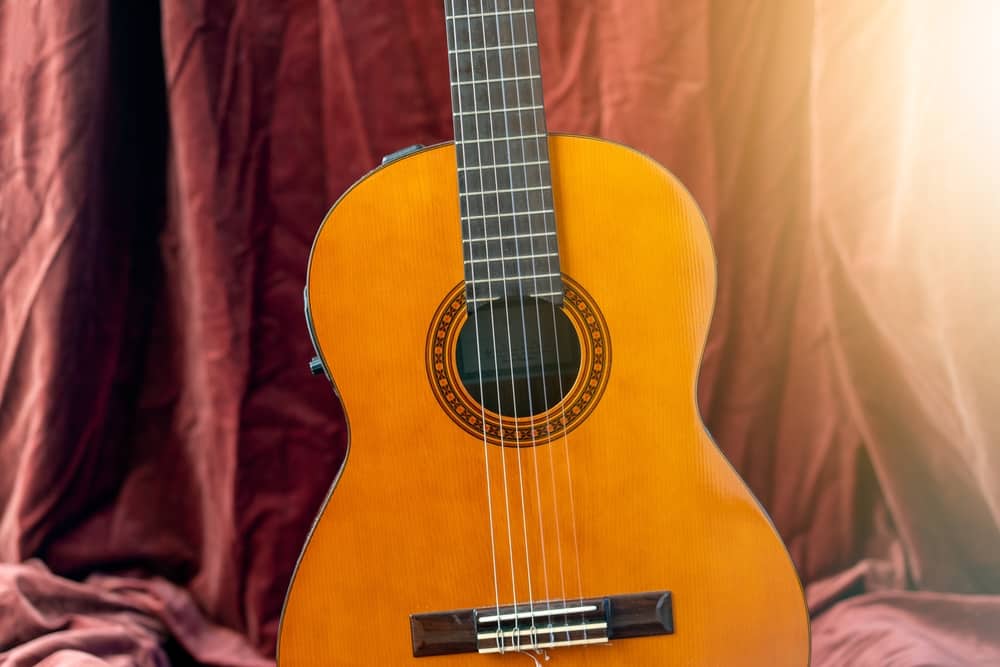
The guitar is probably one of the most versatile musical instruments that can complement all types of music. Today, you can find many different guitars, such as acoustic guitars, bass guitars, resonator guitars, electric guitars, etc.
And of course, there are classical guitars.
Classical guitars are generally used to play classical music. However, there are a lot of factors that distinguish a classical guitar from the regular acoustic guitar and the other types. The most noticeable differences are its shape and build, the kind of sound it produces, and the playing technique.
The classical guitar has been around us for a long time and is one of the most popular and widely used guitars. So, let’s begin learning about a classical guitar’s characteristics in detail.
History of the Classical Guitar
Early forms of the classical guitar date back to the fifteenth and sixteenth-century Spain. That is why it is also known as the Spanish guitar because Spain is the place of its origin. Since then, it has evolved and become the modern classical guitar that we talk about.
Shape and Build

The prominent build and design differences in a classical guitar set it apart from the others. If you know about these differences, you can instantly identify a classical guitar just by looking at the instrument.
Strings
Unlike most other guitars with steel strings, the strings of a classical guitar are made of nylon. Even if the thicker strings are surrounded by a metal spring, they have nylon wire at their core.
Truss Rod
A classical guitar does not have a truss rod, which is a metal rod inside the neck of the guitar. It is usually present in an acoustic guitar because the metal strings put a lot of tension on the neck.
You cannot use steel strings on a classical guitar because all that tension can cause the neck to be bowed.
Neck
A classical guitar has a shorter neck than most other full-sized guitars. The short neck allows for a firm grip and makes the guitar easier to play.
Rosette
You must have seen a colorful design pattern around the soundhole of a classical guitar. That circular design is specific to this guitar and is called a “rosette.” The rosette could be found in many different designs on a classical guitar.
Fretboard
A classical guitar has a wider fretboard than most other guitars. Its fretboard is hollow, making the classical guitar a little fragile and more prone to breakage.
However, the hollowed body allows it to create its proprietary resonant and warm sound.
Lead Curve
Most acoustic and electric guitars have a lead curve, also called the cutaway curve. This curve makes it easier to reach the bottom neck area and execute intricate string strokes.
However, such a lead curve is not present on a classical guitar. It has symmetry going all around the body.
Sound From a Classical Guitar
Describing a musical instrument’s sound is like wine tasting. It can vary from person to person and be perceived differently in everyone’s heads. But there are some specific tones that no other instrument besides the classical guitar can produce.
Classical Music
A classical guitar is specifically used to play classical music.
Classical music has a long history, and it mainly originated from European liturgy and traditional music. The best examples of historically important classical compositions are that of Beethoven and Mozart.
Nowadays, classical music comes outside of Europe as well, for example, from countries like Brazil and Japan.
Rich and Warm Tone
The sound from a classical guitar is vibrant, mellow, and warm. Its body being hollow also contributes to producing this particular sound. Other guitars, such as the acoustic guitar, usually have a much brighter tonal quality. So only classical guitar can make a sound that is so vibrant and mellow.
Playing Technique
Different guitar types have different playing techniques too. A classical guitar also has specific playing patterns and practices that a professional guitarist must follow.
Using Support
You might have seen that guitarists usually wear a strap to support the guitar. Its purpose is to make holding the guitar easier for the player.
Most guitarists who play a classical guitar use some support to hold the guitar in a good playing position. That support can be a footstool or a strap around the neck.
Playing With Fingers
A classical guitarist always uses the fingerstyle technique to play the classical guitar. It means that they use all their fingers to pluck the string. A classical guitar is not played with a guitar pick.
Most of the time, the guitarist uses their fingernails to produce a louder and clearer sound.
Clean Play
Classical music is generally written in staff notation, meaning that the performer cannot alter the piece by himself or can make little to no amendments.
So, a classical guitarist must always play precisely according to the staff and should not miss any note.
This type of flawless performance is called a clean play.
Mellow Sound
An acoustic guitar has metal strings, while the classical guitar has nylon strings which are thicker than the steel ones. That is why the sound from a classical guitar is very mellow and warm.
Additionally, its hollow body makes the sound resonate inside it, so the sound is even richer and clearer.
Conclusion
These were all the differences that set the classical guitar apart from the other types of guitars. The significant differences like the nylon strings, having a wider neck, and even a rosette will help you instantly identify a classical guitar.
No musical instrument is better than the other. It’s just their usage that sets them apart. The same is the case with a classical guitar. You cannot compare two musical instruments and tell which one is better.
Even if you are trying to learn guitar, specifically classical guitar, you must explicitly know the instrument you’re holding. We hope that this article answered all your questions about a classical guitar.









